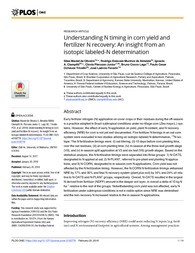Understanding N timing in corn yield and fertilizer N recovery: an insight from an isotopic labeled-N determination.
Understanding N timing in corn yield and fertilizer N recovery: an insight from an isotopic labeled-N determination.
Summary: Early fertilizer nitrogen (N) application on cover crops or their residues during the off-season is a practice adopted in Brazil subtropical conditions under no-tillage corn (Zea mays L.) systems. However, the effect of early N application on yield, plant N content, and N recovery efficiency (NRE) for corn is not yet well documented. Five fertilizer N timings in an oat-corn system were evaluated in two studies utilizing an isotopic-labeled N determination, 15N isotope. The N fertilization timings were: (i) oat tillering, (ii) 15 days before corn planting time, over the oat residues, (iii) at corn planting time, (iv) in-season at the three-leaf growth stage (V3), and (v) in-season split application at V3 and six-leaf (V6) growth stages. Based on the statistical analysis, the N fertilization timings were separated into three groups: 1) N-OATS, designated to N applied at oat; 2) N-PLANT, referred to pre-plant and planting N applications; and 3) N-CORN, designated to in-season corn N applications. Corn yield was not affected by the N fertilization timing. However, the N-CORN N fertilization timings enhanced NRE by 17% and 35% and final N recovery system (plant plus soil) by 16% and 24% all relative to N-OATS and N-PLANT groups, respectively. Overall, N-OATS resulted in the largest N derived from fertilizer (NDFF) amount in the deeper soil layer, in overall a delta of 10 kg N ha-1 relative to the rest of the groups. Notwithstanding corn yield was not affected, early N fertilization under subtropical conditions is not a viable option since NRE was diminished and the non-recovery N increased relative to the in-season N applications.
Publication year: 2018
Types of publication: Journal article
Observation
Some of Embrapa's publications are published as ePub files. To read them, use or download one of the following free software options to your computer or mobile device. Android: Google Play Books; IOS: iBooks; Windows and Linux: Calibre.
Access other publications
Access the Agricultural Research Database (BDPA) to consult Embrapa's full library collection and records.
Visit Embrapa Bookstore to purchase books and other publications sold by Embrapa.

